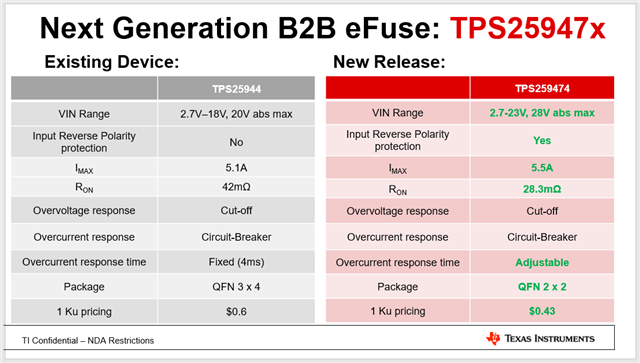Other Parts Discussed in Thread: TPS25944A, TPS25940, TPS2640
Hi Team,
would you tell what are the main advantages and disadvantages between TPS25944A and TPS259474ARPW?
Best Regards,
D.
This thread has been locked.
If you have a related question, please click the "Ask a related question" button in the top right corner. The newly created question will be automatically linked to this question.
Hi D,
Thanks for reaching out. Please see comparison below:

|
Material |
TPS25940/2/4 |
TPS25947x |
|
Max VIN (V) |
18 |
23 |
|
Abs Max VIN (V) |
20 |
28 |
|
Typ RON (mΩ) |
42 |
28.3 |
|
Min Current Limit (A) |
0.6 |
0.5 |
|
Max Current Limit (A) |
5.3 |
6 |
|
Current Limit Accuracy |
9% |
10% |
|
Analog IMON |
Yes (8%) |
Yes (15%) |
|
Bi-directional current |
No |
No |
|
Reverse Current Blocking |
Always |
Always (Linear Oring) |
|
Input Reverse Polarity Protection |
With external diode |
Integrated |
|
Max DC reverse Current(A) |
0.24 |
0 |
|
OC Fault Response |
ILIM/CB |
ILIM/CB |
|
OC Fault response time |
<100us for CL/ Fixed 4ms for CB |
Adjustable |
|
Iq operating (uA) |
200 |
428 |
|
Isd (uA) |
15 |
4.4 |
|
UVLO |
Adj |
Adj |
|
OVP |
Adj OVLO |
Adj OVLO/Pin Sel OVC |
|
PG output |
Yes |
Yes |
|
Fault output |
Yes |
Yes |
|
Quick Output Discharge |
No |
No |
|
Package |
WQFN-20 , 3x4 |
QFN, 2x2 |
Regards
Kunal Goel